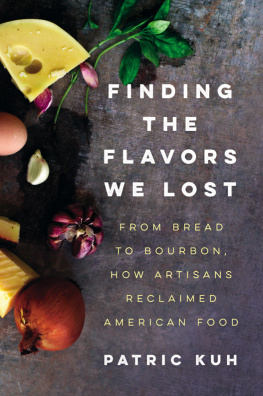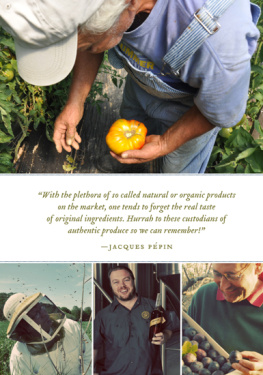128TH AVENUE, FENNVILLE, MICHIGAN
OCTOBER 28, 1978
I t was the day of Alyce Birchenough and Doug Wolberts wedding. The home-brewed root beer was chilling, some friends were setting up their bluegrass instruments on the porch, and others were hauling kegs of beer when a local farmer pulled into the rutted driveway. Hitched to his truck was a trailer holding a single cow. She was to be Dougs present to Alyce, the animal that would help them to revitalize the thirty-three acres of depleted soil theyd settled on in western Michigan. Doug hadnt nailed down the delivery date and, attuned to the casual ways of Fennville, he reasoned this just happened to be a lull when the farmer had time. Still, he was more than a little surprised to learn the cow hadnt been milked. Was that customary? There she was, in the trailer, her udder tight, obviously in pain. Alyce and Doug exchanged a glance. Alyce immediately understood that this was Dougs gift. But today? Had he forgotten to tell the farmer that this was precisely the date not to bring the cow? Then again, maybe he had and this was a rural statement: you wanted country living, well, here you go.
Their relationship with the locals had been much on Alyces mind in the few months since she had moved to Fennville. They lived in the town, a small farming community near the eastern shore of Lake Michigan with an active 4-H youth agriculture club, sport leagues, and churches, but they were not of it. Instead of buying their staples from the local grocery stores, they got them in bulk from a Chicago co-op whose truck intermittently undertook the four-hour drive to service a ragtag group of communes. Alyce winced at how this could be interpreted as rejecting the community, but she had come to the land to be, in a word, de-Twinkiefied, and she was actively pursuing that when she stood by the vehicles rusty tailgate using her own scales to measure out whole wheat flour, brown rice, and chickpeas.
Less than a mile from their homestead, Fenn Valley Vineyards had opened a few years previously and was selling natural fruit wines, but the townspeople mainly thought of it as a curiosity. Alyce and her friends were an even greater one. Dungarees, beards, homespun vests, loose handmade dresses cut from patterns, dinged-up hats; they looked like farmers all rightfrom another century. Still, there was no animosity; perhaps there was even a hint of admiration at their sense of thrift. The newcomers vehiclesa fleet of sputtering, backfiring decal-covered vanswerent going to show up anyones pickup. The home-canned tomatoes that might bring sunshine to a winter table were not that far from what was going on in surrounding kitchens. When a farmer whose peaceable Guernsey was being picked on by the Holsteins in the herd decided to sell her, he put a notice in the local paper and Doug responded. Whatever differences existed had not prevented a sale.
Alyce had gotten into the habit of extrapolating great significance from little evidence. Those times when, driving over the rutted dirt byway that linked their farm to asphalted roads, she received a country greetingfinger lifted off steering wheel from an oncoming carshe could be happy for days. They were being accepted. Now, standing before her, was a farmer pointing out that the cow he had with him hadnt been milked and she understood that instead of a taunt, this was rural showmanship, a way of displaying for them just how much milk the cow could produce.
She could contemplate those subtleties later. There wasnt time for rumination. She saw the cow pawing in its trailer in obvious discomfort. Alyce and Doug had readied a shed across from the house and she led the cow toward it while Doug finished up with the farmer. Rushing back across the driveway and into the kitchen, she found an enamel pail and, remembering quickly the steps of milking shed studied in anticipation of this moment in Carla Emerys The Encyclopedia of Country Living, she raced back out to the animal. Grab high on teat near udder, the first of Emerys three drawings instructed. Applying the gentle pressure that Emery described, while all the time squeezing to force the milk downward, Alyce started the repetitive up-and-down movements. Who was this person she was becoming? She wasnt some kind of pioneer woman who would have been practiced in these farmstead skills. She was someone who less than a decade earlier had been a science major celebrating the first Earth Day with much strumming of guitars on the campus of Southeastern Louisiana University. Now she was taking possession of a cow on her wedding day. Sounds often accompany lifes turning pointsthe creak of a door closing in a place we wont return to, a newborns cryand Alyce felt there was something of that to the hissing the milk made as it hit the bottom of the enamel pail.
BY THE FOLLOWING WEEK DOUG and Alyce had gotten used to the rhythms of milking and named their Guernsey Cindy Lou. The occasional mooing theyd hear from the shed or the sight of her swishing her tail nose down in a tuft of grass contributed a sense of permanence to their new life. It was your typical 1970s homestead: a modest structure, a scrawny garden, some sheds, a three-seater outhouse, and only five workable acres. The poor quality of the landheavy with sand that blew from the deforested edges of Lake Michiganwas part of the reason Doug had been able to buy the property. His first task had been to clear it of the car shells and debris that the previous owners had left. Soon after, hed set up a sawmill that ran from power he took off a rotating tractor belt, and he often accepted lumber in payment for transforming a log into a stack of boards. It was a simple life, punctuated with occasional parties that gathered the local back-to-the-land community in one setting.
Alyce had attended one of those gatherings when, unsure where her life was going, shed first visited Michigan. A New Orleans native, Alyce had moved to Connecticut soon after graduating from college and worked for a time as a nutritionist at YaleNew Haven Hospital. It had been a disappointing experience; the doctors barely took her suggestions seriously. The nods her nutrition and wellness recommendations received were only a maddening form of dismissalthey were never included in the instructions the doctors jotted down. While others might have made their peace with the situation, Alyce saw no need to cede as important a point. Shed left, traveled, and eventually visited a college roommate friend living in the town of Holland, an artistically inclined town on Lake Michigan, fifteen miles north of Fennville.
The two friends had driven down to one of Dougs parties and, over the course of a few weeks, Alyce fell in love with the rangy Wolbert. His farm and its land needed a lot of workthe brush pushed right against the back of the housebut she admired how he was going at it, slowly and alone, armed with little more than a deep appreciation for self-sufficiency, something she, too, shared. Many of the improvements hed made to the hodgepodge house had an endearingly off-kilter qualitypulling a chain in the kitchen let a jet of fresh air in through a roof trapand over repeated visits she started to picture herself joining him in his quiet life. It didnt take much convincing to get her to staystill, she had standards. The three-seater outhouse had to become indoor plumbing. In a climate with only 120 frost-free days a year it didnt seem to Doug such an outlandish demand.
Perhaps a little comfort was perfectly fitting, even deserved. Though there was a long tradition of sects rejecting the trappings of cities, disengagement did not necessarily induce hardship. Rappites, Mennonites, Shakers, Perfectionistsall managed to pursue transcendent goals while enjoying their share of temporal pleasures in the form of breads, dried fruits, vinegars, whiskeys, and hams. Charles Nordhoffs 1875 study of these communities put it succinctly. I have found it generally true, he wrote after years of research, that the members of communistic societies take life easy.











